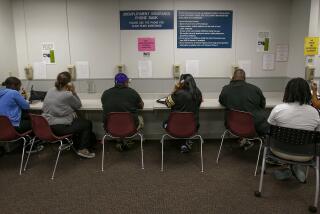Productivity Dips; Labor Costs Rise : Analysts Fear Latest Figures Point to Higher Inflation
- Share via
WASHINGTON — Labor costs rose; productivity fell, and workers, despite higher wages, lost some of their purchasing power in the second quarter, the Labor Department reported Thursday.
At the same time, the Commerce Department reported that construction spending in July posted its sharpest increase in four months, though only partly recovering from a slump in June.
For the record:
12:00 a.m. Sept. 3, 1988 FOR THE RECORD
Los Angeles Times Saturday September 3, 1988 Home Edition Business Part 4 Page 2 Column 2 Financial Desk 1 inches; 28 words Type of Material: Correction
Because of an Associated Press error, the non-farm business productivity chart that appeared in some Friday editions showed a decline for the first quarter of 1988. In fact, productivity rose 3.4%.
Analysts called the productivity report a warning flag of inflation and more difficult economic times.
In revised figures for April through June, the Labor Department said the efficiency of non-farm businesses in churning out goods and services dropped at an annual rate of 1.4%, its first quarterly decline since 1986.
Labor costs, meanwhile, shot up at an annual rate of 5.7%--the biggest increase since 1986--reflecting the productivity declines and wage and benefit increases averaging 4.2% annually.
Charles Renfro of Alaphametrics, an economic forecasting firm in Bala Cynwyd, Pa., said the figures indicate that an “inflationary head of steam is building.”
“Some rise in unit labor costs and a decrease in productivity is a reflection of an economy that is beginning to battle itself,” he said. “The question really is what’s going to hit first: a recession or an inflationary period followed by recession.”
Worker Hours Up
The department had earlier put the productivity decline among non-farm businesses responsible for three-fourths of the nation’s economic activity at a worse 1.7%.
However, that was before the government last week revised economic growth figures for the second quarter upward to 3.3% from 3.1% annually.
With the higher growth, output of goods and service by non-farm businesses in the private sector increased 5.2% instead of the 4.7% estimated earlier.
But to achieve that increased output, businesses had to raise the number of hours worked by their employees by 6.6%.
Analysts said the increase in hours and consequent decrease in productivity reflects a hiring boom in which employers at a time of decade-low unemployment are having to use less-skilled workers more.
“If the marginal labor is less skilled, the result is going to be some productivity declines,” said Renfro. “We may have moved to a point where we have absorbed all of labor’s skilled capacity. That is one of the things that usually characterizes an inflationary period.”
Despite the second-quarter decline, businesses are still 1.6% more efficient than they were a year ago, according to the Labor Department numbers, and labor costs over the 12 months are up just 2.9%.
“Essentially, productivity is still moving upward, although the trend is becoming somewhat discouraging,” said Larry Chimerine of the WEFA Group, another Bala Cynwyd consulting concern.
The Labor Department said hourly wages and benefits nominally rose at an annual rate of 4.2% in the second quarter. But after taking inflation into account, the buying power of each hour of work declined 0.6%, the first drop in real compensation for workers in a year.
The 5.7% increase in labor costs, compared to just a 0.1% rise in the first quarter, was the largest since that last quarter of 1986, when it rose 6.1%.
While businesses as a whole turned less efficient, the rebounding manufacturing sector continued to show large productivity gains, at an annual pace of 3.6% in the second quarter on top of a 3.4% increase in 1987.
In its construction report, the Commerce Department said building activity rose 1.2% to a seasonally adjusted annual rate of $401.0 billion in July, following a revised 1.5% drop in the previous month. The June figure was originally estimated as a slight 0.1% gain.
Construction activity this year has been generally lackluster, seesawing from month to month. The July performance was the strongest since March, while the June decline was the worst in five months.
Office Building Rises
“I think it shows the futility of the Federal Reserve Board raising (interest) rates in expectation of a great (economic) boom. In construction, there isn’t going to be a great boom. I think it’s just sort of plugging along,” said Michael Sumichrast, an economist in Washington who publishes a construction newsletter.
For the first seven months of the year, construction activity was up only 0.9% over the same period in 1987. That doesn’t even keep pace with the 1.9% increase in building costs between the two periods.
The strength in July came from increases in government building projects, offices and apartments. Single-family housing, factories and shopping centers registered declines.
Construction of office buildings in July was up 2.9% to $28.8 billion. Activity in that sector has risen or held steady in every month since February despite high vacancy rates in many parts of the country, particularly the Southwest where the energy industry has slumped.
“It’s incredible. I don’t know why they’re still building, because the amount of empty (office) buildings is staggering,” Sumichrast said.
The July level of office construction was up 9.5% over the same month in 1987.
More to Read
Inside the business of entertainment
The Wide Shot brings you news, analysis and insights on everything from streaming wars to production — and what it all means for the future.
You may occasionally receive promotional content from the Los Angeles Times.









